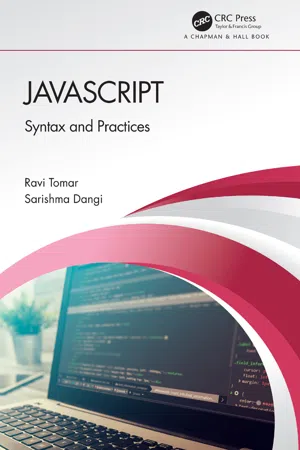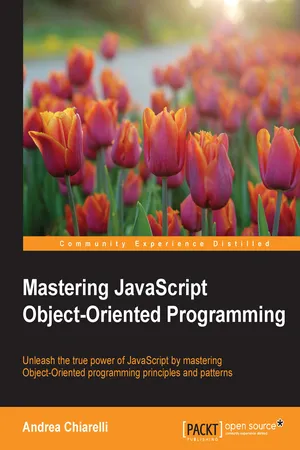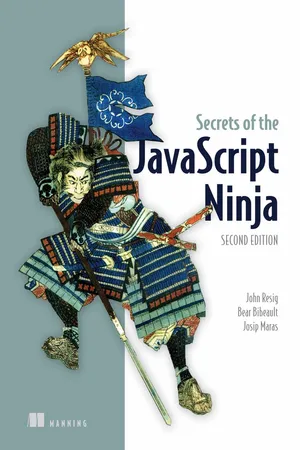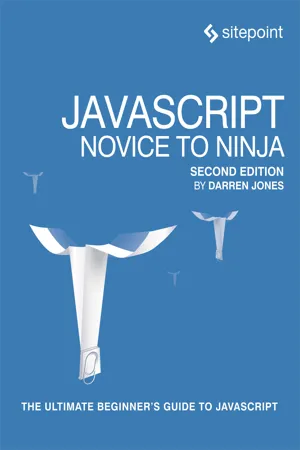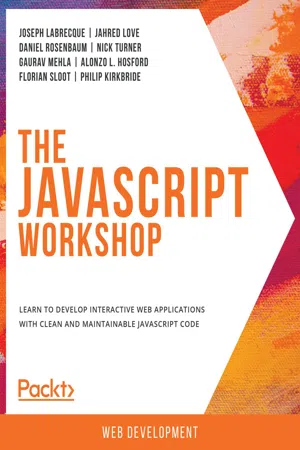Computer Science
Javascript Classes
Javascript classes are a way to create reusable objects with properties and methods. They provide a blueprint for creating objects and allow for inheritance and polymorphism. Classes can be instantiated to create multiple instances of the same object.
Written by Perlego with AI-assistance
Related key terms
Related key terms
1 of 4
Related key terms
1 of 3
10 Key excerpts on "Javascript Classes"
- eBook - ePub
JavaScript
Syntax and Practices
- Ravi Tomar, Sarishma Dangi(Authors)
- 2021(Publication Date)
- Chapman and Hall/CRC(Publisher)
[[Prototype]]. This prototype was used to provide different properties and methods to the newly created object. With the introduction of classes, a clean and more elegant way to empower objects emerged. Classes allow the objects to operate in a safe and clean environment without getting lost in different prototypes and their methods.Object prototype is the generic prototype, and every object inherits from it, regardless of it belonging to a class or not. Therefore, it is not mandatory for objects to always belong to a class in JavaScript. An object can exist independent of a class. A class declaration and definition thus become a matter of choice from a developer's perspective.Coming back to the question, what is a class? In simple terms, a class is a blueprint or a template to generate objects. A class is used as a template to combine objects, its properties and the methods to operate on them. Addition of classes to JavaScript allows developers to easily operate and move between other OOP languages [74] .Class in JavaScript can be defined by using class declaration. The keyword class is used before the name of the class, and it is followed by the declaration statements. The syntax for creating a class is given next.Syntax: class MyClass { // class methods constructor() {… } //Initialize properties method1() {… } //define methods method2() {… } method3() {… }… … }Classes in JavaScript are strictly checked for syntax to increase system performance. Classes operate in a strict mode with strong syntax checking, and this cannot be changed, i.e. classes will always work in strict mode. A class must be declared first and then used; vice versa generates a ReferenceError. Class methods are nonenumerable in nature. Although classes are considered as a special type of functions, such restrictions are not present in functions and are only applicable for classes. As a naming convention, the first letter of class name is always capitalized, which helps in distinguishing a class name within the program.3.7.1 Constructor, Properties and Methods
A class can contain different properties and methods depending upon its design and use. A class is declared using the class - eBook - ePub
JavaScript
The New Toys
- T. J. Crowder(Author)
- 2020(Publication Date)
- Wrox(Publisher)
But classes are more than just the largely static constructs those sorts of languages provide. In the more general sense, for a language to have classes it has to provide two things: encapsulation (bundling data and methods together 1) and inheritance. Having classes isn't the same as being class-based, it's just that the language supports encapsulation and inheritance. Prototypical languages can (and do) have classes and have since before JavaScript was invented; the mechanism they use to provide the second requirement (inheritance) is prototype objects. JavaScript has always been one of the most object-oriented languages you'll find. It's certainly been able to do things in a class-like way since at least ECMAScript 1. Some might pedantically argue it didn't have classes in a computer science sense until ES5 added Object.create to directly support inheritance (even though you could emulate Object.create with a helper function). Others might argue even ES5 doesn't qualify because it lacks declarative constructs and a simple way to refer to superclass methods. But the pedants can stop arguing. As of ES2015, even those objections are laid to rest: JavaScript has classes. Let's see how they work in modern JavaScript. Along the way, we'll compare the new syntax with the old ES5 and earlier syntax. INTRODUCING THE NEW CLASS SYNTAX Listing 4-1 shows a basic example of class : a class whose instances are colors expressed in RGB. (The listing has some method body code omitted, because the goal here is just to show the overall syntax - eBook - ePub
JavaScript for Gurus
Use JavaScript programming features, techniques and modules to solve everyday problems
- Ockert J. du Preez(Author)
- 2020(Publication Date)
- BPB Publications(Publisher)
ECTION IIThe Power of JavaScript
Introduction
Section 2 dives right into the real power of JavaScript. Understanding what makes JavaScript tick is pivotal in creating extremely powerful websites and web applications. In this section, you will learn how to create classes, and then move on to prototypes, properties and promises, finally generators, and modules.This section will have the following chapters:- Classes
- Prototypes
- Properties
- Promises
- Generators
- Modules
Passage contains an image
CHAPTER 6Javascript Classes
Introduction
A JavaScript class creates the structure of its child objects. Although JavaScript is not a full-on object-oriented programming (OOP ) language, it still contains many an OOP feature. Learning how to work with classes is essential to create proper reusable objects.In this chapter, we will focus on Javascript Classes. You will learndifferent ways to create classes and how to instantiate child objects from classes. Properties and methods are next. You will learn how to create basic properties and methods to give your classes better structure and better adaptability. Lastly, you will get a quick introduction to inheritance. There is a lot of work, so let’s get started!Structure
- What are classes?
- Creating a class
- Class declarations
- Class expressions
- Properties
- Properties of properties
- Methods
- Static methods
- Inheritance
Objectives
- Learn what classes are
- Understand the concepts of properties
- Understand the concepts of methods
- Learn what inheritance is
What are classes?
A class, in OOP is a template or blueprint from which objects can be created. A class in JavaScript is a type of function which can be created with a class declaration or a class expression.Creating a class
There are essentially two ways to create a class in JavaScript; they are:- Declaring a class
- Using a class expression
Class declarations
To declare a class, all you need to do is to use the class keyword and supply name of the class, with a constructor. A constructor is a special type of method where the object can be initialized, and it gets called automatically. You can also supply arguments (parameters) to the class here and initialize them as well. Initialization is the assignment (setting) of an initial value for an object or variable. Here is an example: - eBook - ePub
- Andrea Chiarelli(Author)
- 2016(Publication Date)
- Packt Publishing(Publisher)
superclass . Apart from the naming, the inheritance concept is the same, although of course it does not seem suited to JavaScript.We can implement inheritance in JavaScript in various ways. Consider, for example, the following constructor of person objects: function Person() { this.name = ""; this.surname = ""; }In order to define a programmer as a person specialized in computer programming, we will add a new property describing its knowledge about a programming language: knownLanguage .A simple approach to create the programmer object that inherits properties from person is based on prototype. Here is a possible implementation: function Programmer() { this.knownLanguage = ""; } Programmer.prototype = new Person(); We will create a programmer with the following code: var programmer = new Programmer();We will obtain an object that has the properties of the person object (name and surname ) and the specific property of the programmer (knownLanguage ), that is, the programmer object inherits the person properties.This is a simple example to demonstrate that JavaScript supports the inheritance principle of Object-Oriented Programming at its basic level. Inheritance is a complex concept that has many facets and several variants in programming, many of them dependent on the used language.In Chapter 4 , Inheriting and Creating Mixins , we will explore more in depth how JavaScript supports inheritance, analyzing different approaches and more advanced topics such as overriding and multiple inheritance.In Object-Oriented Programming, polymorphism is understood in different ways, even if the basis is a common notion—the ability to handle multiple data types uniformly. Support of polymorphism brings benefits in programming that go toward the overall goal of OOP. Mainly, it reduces coupling in our application, and in some cases, allows to create more compact code.Polymorphism
- eBook - ePub
- Matt Frisbie(Author)
- 2019(Publication Date)
- Wrox(Publisher)
8 Objects, Classes, and Object-Oriented ProgrammingWHAT'S IN THIS CHAPTER?
- Understanding objects
- Understanding object creation
- Understanding inheritance
- Understanding classes
ECMA-262 defines an object as an unordered collection of properties. Strictly speaking, this means that an object is an array of values in no particular order. Each property or method is identified by a name that is mapped to a value. For this reason (and others yet to be discussed), it helps to think of ECMAScript objects as hash tables: nothing more than a grouping of name-value pairs where the value may be data or a function.UNDERSTANDING OBJECTS
The canonical way of creating a custom object is to create a new instance of Object and add properties and methods to it, as in this example:let person = new Object(); person.name = "Nicholas"; person.age = 29; person.job = "Software Engineer"; person.sayName = function() { console.log(this.name); };This example creates an object called person that has three properties (name , age , and job ) and one method (sayName() ). The sayName() method displays the value of this.name , which resolves to person.name . Early JavaScript developers used this pattern frequently to create new objects. A few years later, object literals became the preferred pattern for creating such objects. The previous example can be rewritten using object literal notation as follows:let person = { name: "Nicholas", age: 29, job: "Software Engineer", sayName() { console.log(this.name); } };The person object in this example is equivalent to the person object in the prior example, with all the same properties and methods. These properties are all created with certain characteristics that define their behavior in JavaScript.Types of Properties
ECMA-262 describes characteristics of properties through the use of internal-only attributes. These attributes are defined by the specification for implementation in JavaScript engines, and as such, these attributes are not directly accessible in JavaScript. To indicate that an attribute is internal, surround the attribute name with two pairs of square brackets, such as [[Enumerable]] - eBook - ePub
- Simon Timms(Author)
- 2014(Publication Date)
- Packt Publishing(Publisher)
monkey patching . There is some division over whether or not this is good practice. It can certainly be useful when dealing with library code but it adds great confusion. It is generally considered to be better practice to extend the existing class.Without a proper class system, JavaScript, of course, has no concept of inheritance. What it does have is a prototype. At the most basic level, an object in JavaScript is an associative array of keys and values. Each property or function on an object is simply defined as part of this array.You can even see this in action by accessing members of an object using the array syntax, as is shown in the following code: var thing = { a: 7}; console.log(thing["a"]);Tip
Accessing members of an object using the array syntax can be a very handy way to avoid using the eval function. For instance, if I had the name of the function I wanted to call in a string called funcName and I wanted to call it on an object, obj1 , then I could do so by doing obj1[funcName]() instead of using a potentially dangerous call to eval . The eval function allows for arbitrary code to be executed. Allowing this on a page means that an attacker may be able to enter malicious scripts on other people's browsers.When an object is created, its definition is inherited from a prototype. Weirdly, each prototype is also an object, so even prototypes have prototypes. Well, except for object, which is the top-level prototype. The advantage to attaching functions to the prototype is that only a single copy of the function is created; saving on memory. There are some complexities to prototypes, but you can certainly survive without knowing about them. To make use of a prototype, you need to assign functions to it, as shown in the following code: - No longer available |Learn more
- JD Isaacks(Author)
- 2018(Publication Date)
- Manning Publications(Publisher)
Unit 6. Classes
JavaScript is an object-oriented language. Except for a few primitives, most values in JavaScript, even functions, are objects. Most of the JavaScript code that gets written is for creating custom objects. Many times you’re probably building your own objects from scratch, but sometimes you’ll be starting from a base object provided from a framework or library and adding custom functionality to it. Unfortunately, there hasn’t been a clear way for library authors to provide a base object prototype that can be extended by application developers. This has left many library authors needing to reinvent the wheel.But nobody reinvents the wheel the same way. Here’s how Backbone.js provides a way to extend base objects: Backbone.Model.extend({ // ... new methods }); And here’s how it’s done with React.js: React.createClass({ // ... new methods });Backbone provides a method called initialize that acts as a pseudo constructor function. React does not. But React does autobind its methods when they’re created with createClass. And this is just the beginning of the differences: we quickly compared two here, but there are dozens of JavaScript frameworks that provide a base object, which means that you’d need to remember all the subtle differences of how different classes work depending on what library or framework you’re using.With classes, however, framework authors can now provide a base class that’s extendable at the language level. This means that once you learn how to extend classes with one framework, you’ll be able to transfer that knowledge, making it much easier to switch and learn new frameworks. - No longer available |Learn more
- Josip Maras(Author)
- 2016(Publication Date)
- Manning Publications(Publisher)
Figure 7.17. The instanceof operator checks whether the prototype of the function on the right is in the prototype chain of the object on the left. Be careful; the function’s prototype can be changed anytime!
Now that we understand how prototypes work in JavaScript, and how to use prototypes in conjunction with constructor functions to implement inheritance, let’s move on to a new addition in the ES6 version of JavaScript: classes.7.4. Using JavaScript “classes” in ES6
It’s great that JavaScript lets us use a form of inheritance via prototypes. But many developers, especially those from a classical object-oriented background, would prefer a simplification or abstraction of JavaScript’s inheritance system into one that they’re more familiar with.This inevitably leads toward the realm of classes, even though JavaScript doesn’t support classical inheritance natively. As a response to this need, several JavaScript libraries that simulate classical inheritance have popped up. Because each library implements classes in its own way, the ECMAScript committee has standardized the syntax for simulating class-based inheritance. Notice how we said simulating. Even though now we can use the class keyword in JavaScript, the underlying implementation is still based on prototype inheritance!Note
The class keyword has been added to the ES6 version of JavaScript, and not all browsers implement it (see http://mng.bz/3ykA for current support).
Let’s start by studying the new syntax.7.4.1. Using the class keyword
ES6 introduces a new class keyword that provides a much more elegant way of creating objects and implementing inheritance than manually implementing it ourselves with prototypes. Using the class keyword is easy, as shown in the following listing.Listing 7.13. Creating a class in ES6
Listing 7.13 - eBook - ePub
- Darren Jones(Author)
- 2017(Publication Date)
- SitePoint(Publisher)
index.html in your browser. Providing options that the player can choose from makes the game much easier to play by not requiring any typing:Multiple-choice options in the quizYou can see a live example on CodePen .Chapter Summary
- Object-oriented programming (OOP) is a way of programming that uses objects that encapsulate their own properties and methods.
- The main concepts of OOP are encapsulation, polymorphism and inheritance.
- Constructor functions can be used to create instances of objects.
- ES6 introduced class declarations that use the class keyword. These can be used in place of constructor functions.
- Inside a constructor function or class declaration, the keyword this refers to the object returned by the function.
- All instances of a class or constructor function inherit all the properties and methods of its prototype.
- The prototype is live, so new properties and methods can be added to existing instances.
- The prototype chain is used to find an available method. If an object lacks a method, JavaScript will check whether its prototype has the method. If not, it will check that function’s prototype until it finds the method or reaches the Object constructor function.
- Private properties and methods can be created by defining variables using const and defining a function inside a constructor function. These can be made public using getter and setter functions.
- Monkey-patching is the process of adding methods to built-in objects by augmenting their prototypes. This should be done with caution as it can cause unexpected behavior in the way built-in objects work.
- A mixin method can be used to add properties and methods from other objects without creating an inheritance chain.
- Methods can be chained together and called in sequence if they return a reference to this.
- Polymorphism allows objects to override shared methods with a more specific implementation.
- The value of this is not retained inside nested functions, which can cause errors. This can be worked around by using that = this , using the bind(this)
- eBook - ePub
The JavaScript Workshop
A New, Interactive Approach to Learning JavaScript
- Joseph Labrecque, Jahred Love, Daniel Rosenbaum, Nick Turner, Gaurav Mehla, Alonzo L. Hosford, Florian Sloot, Philip Kirkbride(Authors)
- 2019(Publication Date)
- Packt Publishing(Publisher)
In this section, we have learned about different types of programming paradigms we can use with JavaScript. We dug deep into two of the most popular paradigms – procedural and object-oriented. We went through different pros and cons of both paradigms. We also learned about two of the most important features of OOP, which are encapsulation and inheritance.Basic JavaScript Concepts
Programming paradigms are important, but to understand them in detail, we need a basic understanding of different JavaScript concepts. So, let's go through some of the core concepts of JavaScript, which will help you get a grasp of JavaScript and give you a better understanding of how we can use programming paradigms to build scalable solutions to problems.Prototypes and Prototypical Inheritance
Objects are very important because they help us manipulate JavaScript to achieve the functionality we want. There are a lot of ways to create objects in JavaScript. One of the ways is by using a constructor function, and whenever we create a function, the JavaScript engine adds a prototype property to the function. This prototype property is an object that has a constructor property by default. This constructor points back to the parent functions. You can see this function by calling functionName.prototype .Let's first create a function: function PersonName(first_name, last_name) { this.first_name = first_name; this.last_name = last_name; this.fullName = function(){ return [ this.first_name, this.last_name].join(" "); } }Now, let's check its prototype property by entering PersonName.prototype .The output will be as follows:Figure 13.4: Prototype property of objectsAs you can see, we have created a function named PersonName and JavaScript automatically binds a prototype property to it. You can print the prototype and you can see that there is a constructor property, which holds all the metadata of the parent function.What Is Prototypical Inheritance?
As we know, everything in JavaScript is an object. Every string, integer, array, object, and function that you define is an object of its respective parent class. Each object in JavaScript holds a proto property (__proto__ keys inside child objects are usually referred to as proto properties) that holds all the properties of its parent class. We can use these proto properties to implement inheritance. These prototype objects act as template objects from which all the child objects will inherit methods and properties. We can also override the properties of a parent class using this prototype
Index pages curate the most relevant extracts from our library of academic textbooks. They’ve been created using an in-house natural language model (NLM), each adding context and meaning to key research topics.
Explore more topic indexes
Explore more topic indexes
1 of 6
Explore more topic indexes
1 of 4
